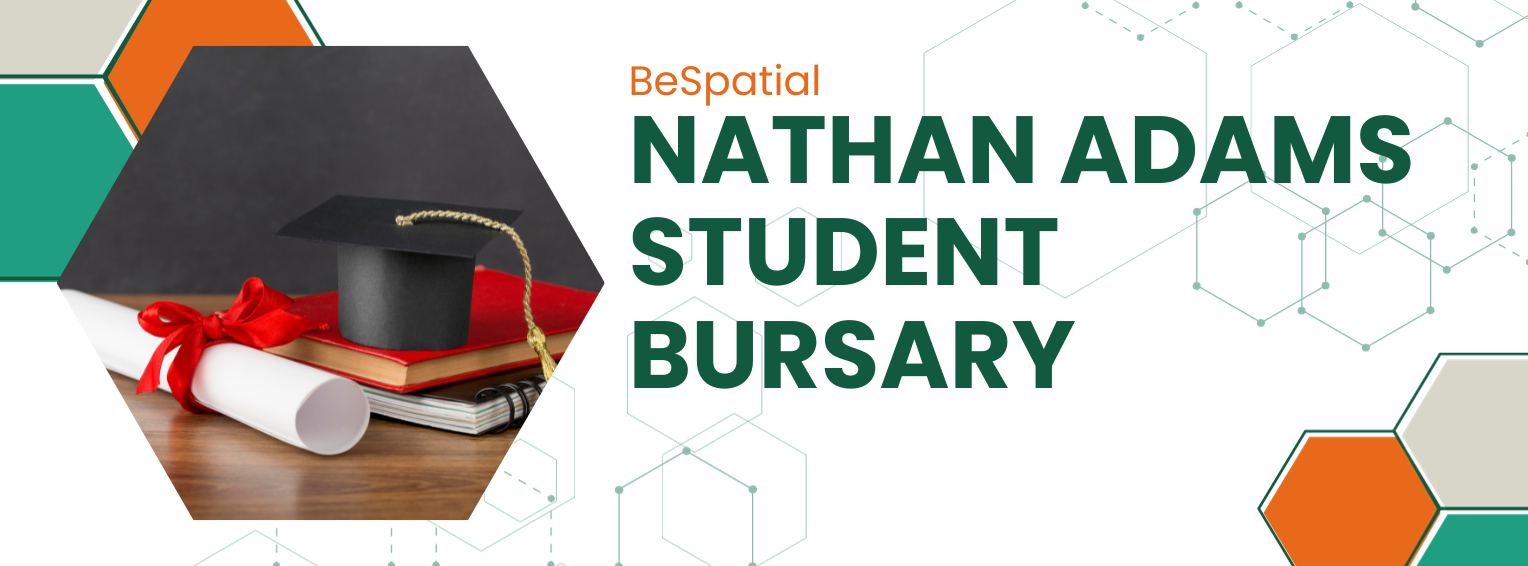|
The BeSpatial Student Bursary was renamed in 2022 in honour of Nathan Adams, a Master’s candidate studying Geography and GIS at the University of Guelph. Nathan had graduated from the University’s undergraduate Geography program and was working on his thesis to develop a new way of using AI for extraction of objects from a LiDAR point cloud when he died due to complications of Type 1 Diabetes at the age of 24 in 2021. Student FlyerThere is a strong connection to the Adams family and BeSpatial Ontario. Nathan's cousin, Sarah Brooke, was the first student to win the award. Nathan’s mother, Dianne Adams, served on the board throughout her career. The Adam’s family is honoured that Nathan’s name will be associated with the annual bursary for other students working towards a degree in the GIS field. Bursary value: $500 The BeSpatial Student Bursary is an annual award that recognizes the contributions of students studying at Ontario post-secondary institutions. This is a great opportunity for students to get name recognition and begin participating in industry events. To be eligible for this award, students must be currently enrolled in a certificate, diploma, post-graduate diploma, undergraduate, or graduate studies program in Ontario. Broad topics for consideration can include the application of GIS in the following areas: Education, Geomatics Engineering, Environment, Natural Resources, Public Safety, Transportation, Facility and Asset Management, Business, and Analytics. The Student Bursary competition is now open for 2025-2026! Submit your projects here. |
Application Guidelines
To be considered for this award, eligible students are asked to submit a story map and short paper detailing their project completed as a requirement for their studies in Ontario. Don't have an Esri account? You can make a free account here. Additional details are as follows:
- Project descriptions should be no longer than 500 words and include its purpose, data used, and the solution that it provides.
- The use of maps and other data visualization elements to describe project results are strongly encouraged.
Questions regarding the bursary, application process, or StoryMap submission should be sent to the attention of the manager of Education.
2025 Nathan adams STUDENT BURSARY WINNER
Aryan Srivastava – Fanshawe College
Geographic Information Systems

Aryan is a student at Fanshawe College enrolled in the Geographic Information Systems program, set to graduate in August 2025. Raised in New Delhi, India he had always wanted to apply advanced geospatial tools to real-world challenges back home, so he came to Canada to gain first-hand experience with leading GIS technologies. His interests centre on spatial analysis, drone-based data capture, and remote sensing—skills he has refined both in class and through field projects.
Aryan's capstone StoryMap, “Flood Risk & Community Awareness in London, Ontario,” integrates city open data, personally captured drone footage and images, and insights from a short Survey123 questionnaire to map Thames River flood vulnerability, visualize past flood events, and assess community preparedness. The project illustrates how community insight and GIS together can guide smarter flood-mitigation planning, and underscore the need for wider public awareness and household emergency-plan readiness.
Long-term, Aryan aims to deploy data-driven flood-management and climate-resilience solutions in Canada, India, and other regions facing similar challenges worldwide.
2024 Nathan adams STUDENT BURSARY WINNER
Helen Plesko - Fleming College
Geographic Information Systems - Applications Specialist
 Snapping Turtle Habitat Suitability
Snapping Turtle Habitat Suitability
Helen Plesko is a student at Fleming College enrolled in the Geographic Information Systems - Applications Specialist program, set to graduate in June 2024. She has also achieved her Bachelor of Education in the Queen's-Trent concurrent education program.
Helen's project focused on determining the available suitable habitat for the Chelydra serpentina, more commonly known as the snapping turtle, is an incredible reptile that lives in the southeastern area of North America. As part of her submission, Helen developed a Story Map that explains her methodology, results, and map products she produced in her site suitability analysis. You can view her storymap here.
2023 Nathan adams STUDENT BURSARY WINNER
Hannah Flores - University of Toronto
Biodiversity and Conservation Biology, Faculty of Arts and Sciences
 In the Line of Fire, The homes of Amazonian indigenous peoples are turning to ash
In the Line of Fire, The homes of Amazonian indigenous peoples are turning to ash
Hannah Flores is a second-year student at the University of Toronto (St. George) studying human and environmental biology, and Spanish. Inspired by her Guyanese and Cuban heritage, Hannah was eager to study a growing concern at the nexus of environmental health, geography, and indigenous sovereignty in the Amazon: how forest fires impact the health of Amazonian indigenous populations.
As part of her submission, Hannah developed a Story Map that aimed to visualize the geographical infiltration of wildfires into Amazonian indigenous territories as of 2022. Beyond the geographical lens, this Story Map uses scientific, journalistic, and ethnographic data sources to convey the severe negative impacts that these fires have on the forest environments that indigenous communities call home, and the life-threatening health effects that the fires have on isolated indigenous tribes.
2022 Nathan adams STUDENT BURSARY WINNERMelissa Jade Greco - University of WaterlooHonours Planning, Faculty of Environment
The purpose of this project is to provide a snapshot of crime statistics based on all cases reported to the Waterloo Regional Police Service (WRPS) in 2019. Graduated symbols and choropleth maps are used to represent the geographic distribution of the total crime occurrences in the Region of Waterloo, as well as the distribution of three specific types of occurrences of interest, including breaking and entering, assault, and drug related cases. The analysis may be used to illustrate which areas of the city have the highest total crime occurrences, and thus, which may require the most police resources. The project uses crime occurrence data published by the WRPS in CSV format as well as open data from the Region of Waterloo (e.g., regional boundary shapefile). ArcMap and ArcGIS online were used for data processing and map production. As mentioned, graduated symbols maps and choropleth maps are used to identify patterns in the data and identify crime hot spots. Numerous geoprocessing tools were used in the creation of these maps, such as the XY table to point, generate tessellation, select by location/attribute, collect events, and spatial join geoprocessing tools. |
2021 STUDENT BURSARY WINNERXuyang Han - York UniversityGeomatics Engineering
Abstract: Today, maritime transportation represents substantial international trade. Sustainable development of marine transportation requires systematic modeling and surveillance for maritime situational awareness. In this research, we present an enhanced density-based spatial clustering (DBSCAN) method to model vessel behaviours. The proposed methodology enhances the DBSCAN clustering performance by integrating the Mahalanobis Distance metric that considers the correlations of the points representing the locations of the vessels. The clustering method is applied to historical Automatic Identification System (AIS) data by proposing an algorithm for generating a clustering model of the vessels' trajectories and a model for detecting vessel trajectories anomalies such as unexpected stops, deviations from regulated routes, or inconsistent speed. Besides, an automatic and data-driven approach is proposed to choose the required initial parameters for enhanced DBSCAN. Two case studies present outcomes from the openly available Gulf of Mexico AIS data and Saint Lawrence Seaway and Great Lakes AIS licensed data acquired from ORBCOMM (a maritime AIS data provider). This work's findings demonstrate the applicability and scalability of proposed method for modeling more water regions, contributing to the situational awareness, vessel collision prevention, safe navigation, route planning, and detection of vessel behaviour anomalies for auto-vessels development towards the sustainability of marine transportation.
|





.jpg) Mapping Crime in Waterloo (2019), An Analysis of Total Crime Occurrences in the Region of Waterloo
Mapping Crime in Waterloo (2019), An Analysis of Total Crime Occurrences in the Region of Waterloo
 3-D Datascape Mapping of Toronto
3-D Datascape Mapping of Toronto Studying Invasive Plant Distribution by Using GIS
Studying Invasive Plant Distribution by Using GIS